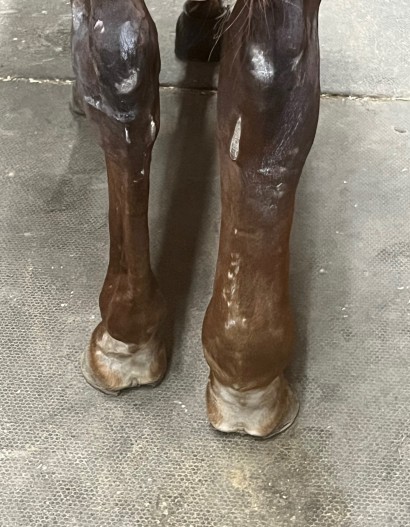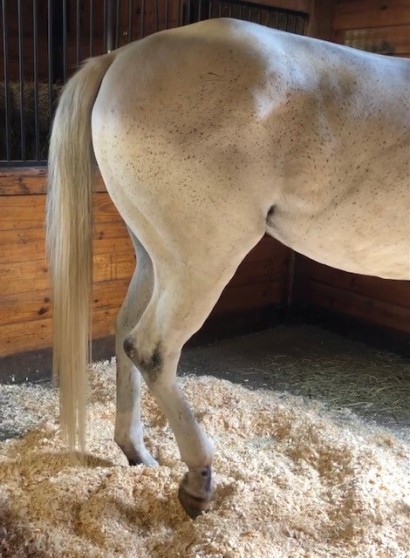Seriously Swollen – Lymphangitis and Cellulitis in Horses
By: Andris J. Kaneps, DVM, PhD, DACVS, DACVSR | Updated September 15, 2025

What is Cellulitis in Horses?
Cellulitis is a painful swelling of the horse’s limb that can result in severe lameness, extreme sensitivity to touching the swollen area, fever, and depression. Horses’ hind limbs are most commonly affected by cellulitis with only one leg involved at a time in most cases.
The pain and swelling are caused by an infection or inflammation of the subcutaneous tissues beneath the horse’s skin. Inflammation leads to extra tissue fluid (edema), which causes swelling. The normal outflow of fluids from the affected leg is reduced because of the fluid overload and infection/inflammation, so the edema progresses significantly.
The lymph nodes that drain the affected region of the leg may also be overwhelmed with fluid and bacteria, resulting in swollen areas high up the leg.
Ask the Vet Video on Cellulitis
Dr. Lydia Gray gives an overview of cellulitis in horses in this Ask the Vet video, including how to recognize this versus other types of swellings and what immediate actions you should take.
Causes of Cellulitis in Horses
Cellulitis is usually caused by a bacterial infection of the subcutaneous tissue - the deepest layer of connective tissues of the skin. The infection is often due to either gram positive bacteria (Staphylococcus or Streptococcus) which are usually found on the skin, or gram negative bacteria (Escherichia coli). The bacteria may access the horse’s subcutaneous tissue through a wound, scratch, abrasion, or dermatitis such as “scratches” or “greasy heel.”
Other uncommon causes of an infection that leads to cellulitis are surgery or joint injections.
Signs and Symptoms of Cellulitis

- Painful leg swelling
- Moderate to severe lameness
- Fever (greater than 101.5°F)
- As signs progress, skin may break or crack and ooze serum
The most obvious clinical sign of cellulitis is extensive swelling of the leg. Swelling often starts in the lower leg, near the pastern, fetlock, or below the hock, and can quickly spread to involve most of the limb. The horse’s leg may be warm to the touch and is usually very sensitive to pressure.
The horse’s level of lameness varies from moderate to severe, with some horses being non-weight bearing on the leg.
Other Conditions with Similar Signs or Potential Causes of Cellulitis:
- Limb edema, known as stocking up, such as a swelling of the lower leg that happens after stabling overnight. Common edema is not painful to the touch and the horse is not lame as he would be with a case of cellulitis. This kind of swelling usually resolves itself with exercise.
- Trauma to the limb (such as a fracture or strain).
- Joint or tendon sheath infection.
Lymphangitis vs Cellulitis

Lymphangitis is similar to cellulitis, but it is caused by inflammation, not an infection. The lymph system is found under the skin and is like a mesh of small blood vessels, however, lymph vessels carry tissue fluid (lymph), not blood.
Compared to cellulitis, horses affected with lymphangitis usually are not as lame, the leg swelling is not as painful to the touch, and most horses will not have a fever.
Since so many of the signs of cellulitis and lymphangitis are similar, making a diagnosis may not be possible in the early phase of either condition. Veterinarians usually recommend treatment for the worst-case scenario, which would be cellulitis.
Treatment of Cellulitis in Horses
If your horse has the signs of cellulitis described above, call your veterinarian for specific advice. Your vet will ask several questions that may help identify the potential cause of the swelling and help them make appropriate treatment recommendations.
Veterinary Care is Critical
When your veterinarian arrives to examine your horse, they will conduct a full examination by taking vital signs (rectal temperature, heart rate, breathing rate, gum color and refill time).
Your veterinarian will watch your horse walk to determine the level of soundness and palpate the affected limb(s) to determine sensitivity to touch, warmth of the limb, and if any wounds or dermatitis may have contributed to the infection. In many circumstances, blood and tissue samples will be taken for analysis and an effort to culture potential causative bacteria.
In most cases of cellulitis, your horse will be treated with broad-spectrum antibiotics and non-steroidal anti-inflammatory medication. In certain cases, advanced methods of antibiotic delivery, such as limb perfusion, may be necessary. If the leg swelling has resulted in oozing of serum through the skin, topical antibacterial agents such as silver sulfadiazine cream are often applied. Complications may include extensive sloughing of the skin or laminitis.
Pain management is critical for severe cases of cellulitis. Non-steroidal agents alone are often not enough to relieve your horse’s pain. Other pain relief options include using opiates and various other pain-relieving medications that are administered via a continuous rate intravenous infusion or through an epidural.
Secondary Care Horse Owners Can Provide

Cold hosing the leg with a high-pressure spray may be recommended to decrease the swelling.
Dry, cold therapy ice boots with compression are very useful for horses with cellulitis or lymphangitis. Look for compression boots that have adjustable compression pressure. This is important when the limb is very sensitive to the touch, and sequentially pressurizes a lower section of the leg, then the next higher section, and so on up the limb.
Your veterinarian may recommend wrapping the leg with a poultice or sweat is to help reduce swelling. Leg sweats reduce swelling by increasing blood flow to the treated limb, thus helping to resolve edema. Sweats may include topical agents such as nitrofurazone with or without DMSO, mineral oil, or glycerin.
Depending on your horse’s unique case of cellulitis or lymphangitis, you will want to work closely with your veterinarian and not put products, ointments, or wraps on their legs without your vet’s advisement.
Exercise and Riding a Horse with Cellulitis
If your horse is comfortable enough to take a walk, then regular hand walking several times daily may be suggested as movement helps resolve the severe edema. Therapeutic exercise starts with hand walking and gradually progresses to under saddle work based on the horse’s level of comfort. Changes in your horse’s exercise regime should only be made after speaking with your veterinarian.
Preventing Bouts of Cellulitis
Horses that have a case of cellulitis are predisposed to future repeat episodes because of potential damage to the circulatory and or lymphatic system. Here are some tips to help prevent future bouts of cellulitis in your horse:
- Maintain a regular schedule of active exercise, such as riding or groundwork (longeing).
- Provide access to daily turn out and/or regular hand walking.
- Pay close attention to your horse’s skin. Treat conditions that could cause a skin infection, like scratches, right away to prevent a bout of cellulitis. Muddy, wet conditions can lead to skin issues on the lower legs, which can then be entry points for bacteria.
At the first sign of recurrence, start treatment as recommended by your veterinarian – for example, high-pressure cold-water therapy, bandaging, and increased exercise.
Recovery and Prognosis
Recovery from a bout of cellulitis may require days to weeks and recovery time varies depending on the extent of the infection or inflammation. Rates of a full recovery are reported to be guarded (55-89%), yet most horses with cellulitis will have a return to their previous level of work.
Some horses will continue to have a thicker limb after the cellulitis. This is because there can be scarring of the subcutaneous tissues and damage to their circulatory and/or lymphatic system. Swelling may persist for a lengthy period, even when the infection is completely resolved, due to the horse’s circulatory and lymphatic systems being impaired.
As previously mentioned, horses that have cellulitis once may, unfortunately, have it again.
Evidence-Based References
- Adam EN, Southwood LL. Primary and secondary limb cellulitis in horses: 44 cases (2000- 2006). J Am Vet Med Assoc 231:1696-1703, 2007.
- Fjordbakk CT, Arroyo LG, Hewson J. Retrospective study of the clinical features of limb cellulitis in 63 horses. Vet Record 162:233-236, 2008.
- Getman LM. Alternative therapies for cellulitis. Proceedings, American College of Veterinary Surgeons, 585-587, 2011.
- Duggan M, Mair T, Fews D. Equine cellulitis/lympangitis resulting in distal limb ischaemia and avulsion of the hoof capsule. Equine Veterinary Education, 2021.
- Keckler, K. Lymphangitis: a frustrating condition. In: Horse Health. American Association of Equine Practitioners.